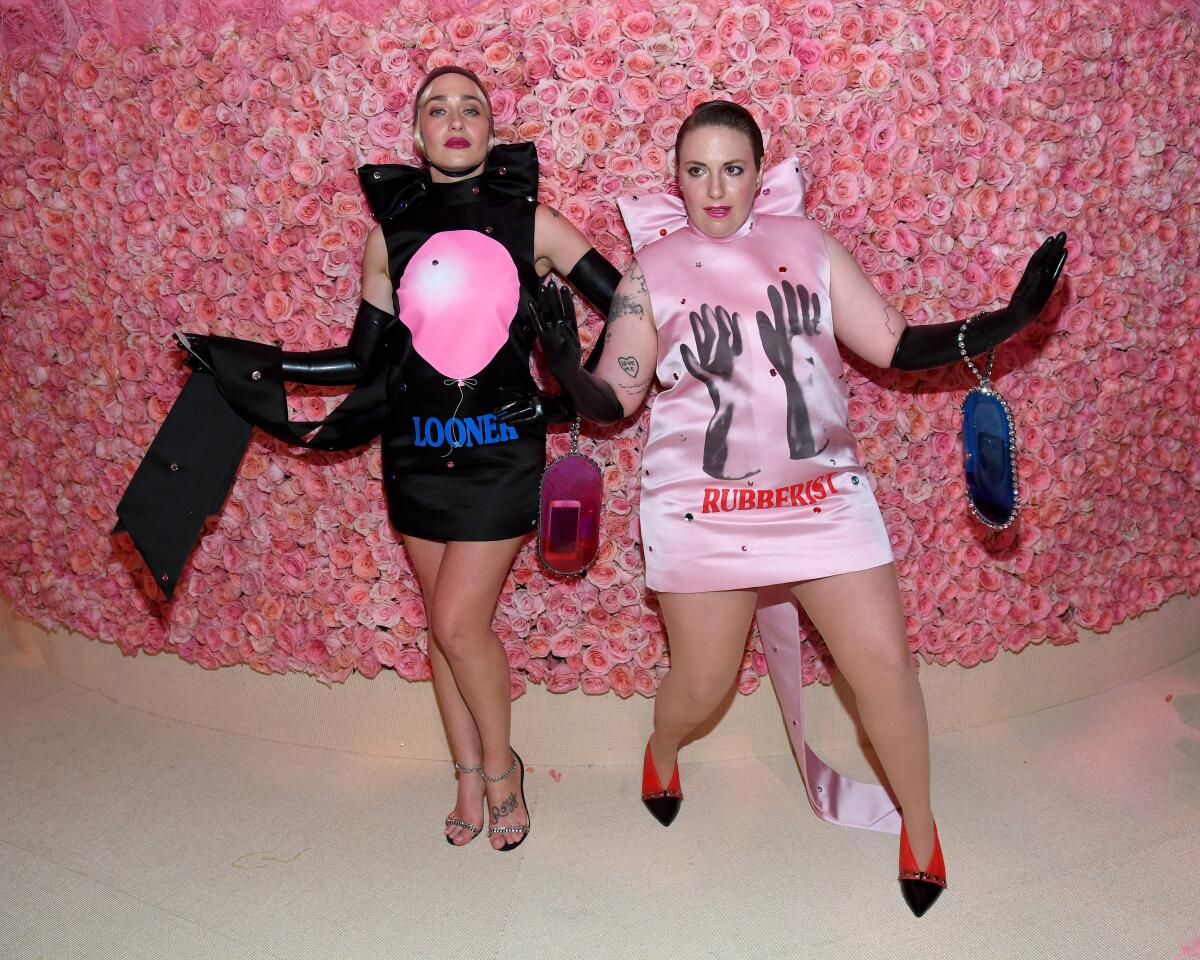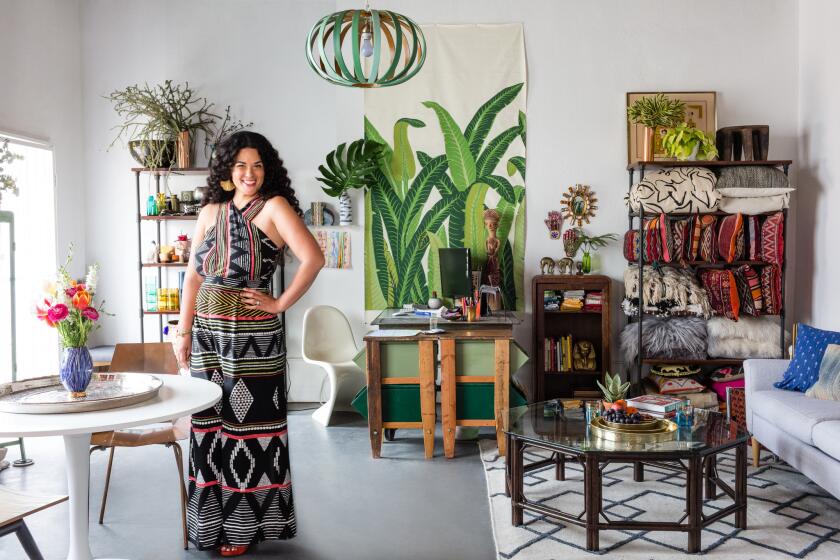What are you willing to wear on your next Zoom? Fetish fashion is on the rise
You might call it the roaring ’20s for some Angelenos, but maybe not in the way you’re thinking. Not everyone spent the last year stuck inside, eating frozen pizzas or making maple syrup or baking bread or catching up on the latest shows on Netflix.
Although the pandemic may have hurt retail sectors, sales figures for niche goods, particularly sex toys and fetish fashion, helped tell another pandemic story.
Sales last year were strong, say L.A. designers of fetish fashion, a category that includes bodysuits, crotchless underwear, bralettes, ball gags and pants made from materials such as leather, latex, vinyl, silicone and synthetic rubber.
“Compared to 2019, sales grew by 466% in 2020,” says designer Mariano Cortez of L.A.-based fetish-wear studio Busted, which offers fetish pieces ranging from latex masks and corsets to latex pants and dresses.
Designer Laura Petrielli-Pulice, founder of L.A. fetish-wear studio Vex, says she also saw a pandemic-era spike in sales with more than 3,093 garments selling on her website. The figure doesn’t include her more upscale custom orders for celebrities who might wear latex garments for performances or photo shoots.
“Thankfully I already had an online store outside of all the celebrity and custom work I do,” Petrielli-Pulice says. “My web shopping was up 145% last year.”
“Over the last year our sales have increased,” says Zana Bayne, a designer who launched her brand in 2010 with operations in Los Angeles. “There were new people discovering the brand through Instagram every day. ... We’ve always been really strong in terms of a direct-to-consumer, e-commerce presence. Because we had that already in place before the pandemic, we were able to build on it.”
Bayne’s appointment-only showroom is more of a working studio than a store. “I’m able to have more space here than in New York and I’m able to produce 100% in-house,” says Bayne, who closed her New York showroom in 2019. “We have all of our own machinery. So the production process didn’t stop during the pandemic. We had some employees who were able to set up at home.”
These increased sales suggest that Angelenos stuck at home last year were seeking avenues of expression and pleasure and found ways to escape boredom or pandemic fears through leather harnesses, latex gloves and TikTok fetish videos.
The unplanned hours during the pandemic have offered plenty of moments to open a fresh browser window and explore adult-oriented offerings from strip clubs launching their own virtual entertainment to professionals, influencers and amateurs creating free and paid sexual content for OnlyFans, a London-based content subscription service.
Bayne, who collaborated with Marc Jacobs and made accessories worn by celebrities including Lady Gaga and Madonna, says the renewed interest in the fetish-fashion category, in particular, is happening because of increased visibility in digital media. Also, recent attention has ballooned in part because of articles about the fetish community, including profiles of well-known dominatrices, in newspapers and magazines.
But does all of this pandemic fuss make 2021 peak fetish then?
Despite the growing interest, Bayne, who prefers to work with leather rather than latex, isn’t sure that fetish wear has gone completely mainstream. “There’s always an ebb and flow,” she says. “Every year a celebrity will wear something fetish related, and there will be a lot of people asking if fetish is more mainstream. I think fetish aesthetics will always be rooted in something taboo with the mainstream. But during the pandemic, as we’re all living through Instagram and other online portals, people are looking to express themselves more at home. These statement pieces then have an increased appeal.”
For some influencers, the pandemic was time for incorporating social distancing into their content.
Connoisseurs of fetish gear include people working in the entertainment and adult industries as well as everyday consumers who like the apparel’s dominatrix aesthetic. Retailers say that not all shoppers of fetish wear are in kink communities. Some consumers, particularly women and members of the LGBTQ community, wear these garments and accessories to express power and dominance while accentuating their curves or bulky muscles.
Although she sells to customers internationally, Bayne says Los Angeles is home to her most passionate customers. “What makes Los Angeles unique is transit. If you’re sitting in your car, you can wear a riskier piece while going from Point A to Point B,” she says. “You don’t run the risk of getting harassed in public. I’ve never felt so free, in terms of what I wear, as I do here.”
‘It’s a way of life’
Fetish wear has been a subcategory in the fashion industry for decades, and in the way that people have reactions to nudity or physical contact, others have similar erotic reactions to seeing, touching or hearing the movement of fabrics and materials such as latex, vinyl and leather.
By 1974, Vivienne Westwood showed that fetish themes are, according to historian Valerie Steele’s book “Fetish: Fashion, Sex & Power,” “increasingly assimilated into fashion.” That’s when the now-80-year-old British designer turned her store into a fetish boutique and renamed it Sex.

In the decades since, fetish apparel has appeared in fashion shows by labels Christian Dior, Thierry Mugler, Dolce & Gabbana, Givenchy and Versace, and designers and retailers have gone mainstream and diversified their fetish and fetish-inspired collections beyond clubwear.
In general, sexual fetishes have been a theme explored in film such as the “Fifty Shades” series and in new books including writer Jane Boon’s novel “Edge Play,” which was published last year.
For more fresh takes on the subject, look no further than Scottish designer Christopher Kane’s fall/winter 2019 collection — it offered a sartorial celebration of fetishes such as “Looner” and “Rubberist” — or recent fetish-inspired looks worn by Beyoncé, Lady Gaga, Kendall Jenner or Kelly Clarkson.

One of the most popular materials used in fetish wear is latex, which has a distinct texture and clings to and easily molds the body. As a bonus, it makes a specific sound that emphasizes movement. Some latex fans find it aesthetically pleasing, while other aficionados crave or require it to have a satisfying erotic experience.
“Latex is completely different from other materials because, for some people, it’s a way of life,” says Renee Dekker, marketing and business manager at the Demask fetish fashion store in the Netherlands. (The European retailer, which had a bricks-and-mortar L.A. outpost, shuttered its American store because of the shutdown. The brand still has an online store and a flagship shop in Amsterdam.)
“It’s really a happy shopping experience for people, more than other items. It’s totally different than working with a normal shop,” Dekker says. “In a lot of cases, people are insecure or unsure but have this fascination. They have this fetish they are curious about but still haven’t worked out. Shopping for this latex is a big step.”

Cortez originally opened his appointment-only studio in Los Angeles as a streetwear boutique in 2016, with a style heavily influenced by underground subcultures. He shifted to focusing on fetish gear in 2018, although his brand still offers sweatshirts and other casual tops. Cortez says customers love bolder looks with a luxurious yet unabashedly BDSM aesthetic.
“We really tried to highlight the wearability of latex. It’s not only a fetish material,” Cortez says. “It’s a fun way to express yourself in uncertain times.”
Cortez says accessories such as latex gloves and masks have been top buys for consumers.
“Where we are in Los Angeles is great because of the entertainment industry,” Cortez says. “There was a huge boom in 2020 with the entertainment industry using latex, celebrities like Lady Gaga and the Kardashians. We do a lot of celeb work. Now most people are familiar with latex.”
Since 2000, Petrielli-Pulice’s studio has offered a range of jackets, stockings, gloves, full catsuits, pants and dresses. She agrees with Cortez about latex. “Now latex is so popular it has, for sure, spilled over into many different genres,” Petrielli-Pulice says. Vex’s fetish selections generally cost between $90-$900.
What items have been popular this last year? For Petrielli-Pulice, top sellers have been gloves, bodysuits, leggings and stockings, which have been sought after by customers outside the entertainment industry.
“We need to increase intercultural understanding and communication,” says designer Justina Blakeney. “Art and design can be a bridge.”
Bayne says her bandanna was the most popular item because it can be used as a face covering.
Beyond the challenges
The last year hasn’t been without problems for some fetish designers. During most of the pandemic with stores closed or opened with limited capacity, most retailers turned to their e-commerce shops as well as social media to promote and sell goods. That wasn’t the easiest option in the fetish community.
Petrielli-Pulice says social-media platforms, including Instagram, have censored images featuring models in latex.
Although there’s no official policy against fetish fashion, nudity and sexual solicitation are prohibited on Instagram. However, form-fitting fetish garments are so sexualized that they are often wrongly categorized.
“Because latex is seen as inherently sexual, many of our products are not approved to be shown in our Instagram shop,” Petrielli-Pulice says. “We overcome it by using things like Linktree to drive traffic and sales to our website. We also cross-promote on different social media platforms to ensure our audience is seeing what we post.”
According to Liza Crenshaw of the Instagram communications team, the social media platform doesn’t have a policy against images of latex garments or fetish fashion, assuming those images don’t involve nudity.
“There may be some cases where we would limit how we’re recommending” latex fashion content, Crenshaw says. “We want our platform to be a place where people as young as 13 feel safe.”
Social media posts, however, weren’t the only obstacle for fetish designers during the pandemic. Petrielli-Pulice and Cortez say that shipping delays were as well.
The Netflix show “Firefly Lane” sparked me to reconsider my friendships as the pandemic world reopens.
The designers say shipping delays during the last year were a major nightmare as disruptions refigured supply chains and distribution flows for fashion retailers. Both have small crews in L.A. working behind the scenes on garments and fetish goods and sales and they have adjusted to pandemic-era setbacks and delays.
“All of our latex comes from the U.K. For half the year, we weren’t able to get another shipment,” Cortez says. “Luckily, a manufacturer in Los Angeles, the Stockroom, let us buy latex from them. We went from shipping an average of 30 packages a month to 200 packages a month. It took about six months to get it under control.”
Thinking about the pandemic and the spike in business, Cortez says, “People are thinking more about latex this year because there isn’t a lot else going on. Valentine’s Day was different this year.”
More to Read
Sign up for The Wild
We’ll help you find the best places to hike, bike and run, as well as the perfect silent spots for meditation and yoga.
You may occasionally receive promotional content from the Los Angeles Times.













